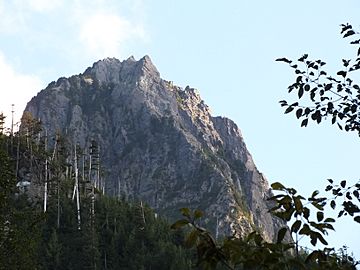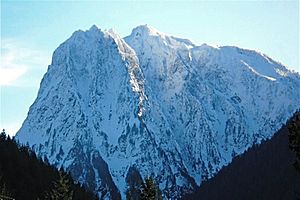Mount Index facts for kids
Quick facts for kids Mount Index |
|
|---|---|
 |
|
| Highest point | |
| Elevation | 5,991 ft (1,826 m) NGVD 29 |
| Prominence | 2,991 ft (912 m) |
| Geography | |
| Parent range | Cascade Range |
| Topo map | USGS Index |
| Climbing | |
| First ascent | First recorded ascent on October 29, 1911 by H. B. Hinman, Ernest Martin, Lee Pickett, George E. Wright |
| Easiest route | Hike/scramble |
Mount Index is a cool mountain peak in the middle of the Cascade Range in Washington state. It's located near the Skykomish River and U.S. Route 2, right at the western edge of the Cascades. Even though it's not as tall as some other Cascade peaks, it's super famous and looks amazing because it stands out so much from the land around it. This is called its topographic prominence.
Mount Index has three pointy tops, or spires, that shoot up sharply from a low base. The main peak is the one furthest south. The North Peak looks even steeper from the valley below. For example, it rises over 4,250 feet (1,300 meters) from its lower slopes in less than one mile (1.6 km) horizontally.
The first time people officially recorded climbing the main peak of Mount Index was on October 29, 1911. The climbers were H. B. Hinman, Ernest Martin, Lee Pickett, and George E. Wright. However, when they reached the top, they found a flagpole already there! This means someone else had climbed it before them. Since the easiest way up doesn't need special climbing gear, it's very likely that Native American people climbed it much earlier.
The steeper and harder North Peak was first climbed in 1929. Lionel Chute and Victor Kaartinen made this first ascent using a path called the North Face Route.
Climbing Mount Index
The most common way to climb the main peak of Mount Index is from its east side. This route starts near Lake Serene. For the North Peak, the usual path is the North Face Route. This is a long climb that needs some technical skills. It's rated as a moderately difficult climb (Grade III, Class 5.6).
Mountain Names
Mount Index wasn't always called Mount Index. It used to be known as West Index Mountain. And another mountain nearby, Baring Mountain, was actually called Mount Index back then! Both mountains got their names changed in 1917 to what they are today.
Climate Around Mount Index
Mount Index is in a part of western North America that has a marine west coast climate. This means the weather is often influenced by the ocean. Most of the weather systems, like big clouds and storms, start over the Pacific Ocean. They then travel northeast towards the Cascade Mountains.
When these weather systems reach the Cascade Mountains, the tall peaks force the air to rise. As the air goes up, it cools down and drops its moisture. This causes a lot of rain or snowfall on the Cascades. This process is called Orographic lift. Because of this, the western side of the North Cascades gets a lot of precipitation, especially snow in the winter.
Since the climate is mild and close to the Pacific Ocean, areas west of the Cascade peaks rarely get super cold (below 0°F or -18°C) or super hot (above 80°F or 27°C). In winter, it's usually cloudy. But in summer, high pressure systems over the Pacific Ocean often bring clear skies. Because the snow is influenced by the ocean, it tends to be wet and heavy. This can lead to a high risk of avalanches, which are dangerous slides of snow down the mountain.



